- Yokohama-shi Top Page
- Municipal Government Information
- Policy and Initiatives
- Major Initiatives
- Base measures
- History of Requisition
- Progress of urbanization and base problems (from 1962 to 1989)
Here's the text.
Progress of urbanization and base problems (from 1962 to 1989)
Last Updated March 19, 2024
Progress of urbanization and base burden
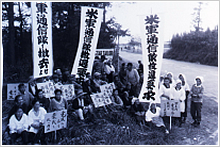
At the Kami Seya Communication Facility, sitting was held in response to restrictions on the prevention of radio interference, seeking land return. (1961)
With the rapid progress of urbanization during the period of high economic growth since the latter half of the 1980s, the base problem also became apparent.
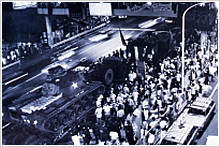
The "Murasame Bridge Incident" was prevented from transporting tanks loaded from Yokohama North Dock. (1972)
At the Kamiseya Communication Facility, the use of equipment around the facility and the construction of buildings were severely restricted in order to prevent U.S. military reception problems. In addition, transmission from Fukaya Communications Station caused TV reception problems in the surrounding area. The radio interference prevention restricted area of Kamiseya communication facility was abolished in 1995, but has been burdening citizens' lives for many years.
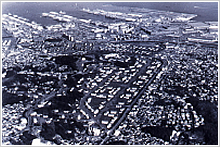
A panoramic view of the Yokohama Seaside Residential Area in Shinhonmoku. (around 1981)
In the Yokohama Seaside Residential Area, etc., a campaign for early return and reconstruction centered on landowners was developed.
Amid such efforts, the United States and Japan conducted a full review of U.S. military facilities in Japan, and agreed on a U.S. military facility and area adjustment plan in 1968, and the Negishi Racetrack area (currently Negishi Forest Park) and residential areas and related facilities located in the city area have been returned.
| Showa | Major Events |
|---|---|
| 37 years | January 25: U.S.-Japan agreement on setting of restricted areas for radio interference prevention of Kamiseya communication facilities Nov. 1: Establishment of Defense Facilities Agency |
| 1939 | May 21: Kanagawa Prefectural Base-related Prefectural Municipal Liaison Council Formed |
| 40 years | February 7: Beginning the Vietnam North Bombing |
| 43 years | December 23: U.S.-Japan agreement on U.S. military facilities and area coordination plans |
| 44 years | March 27: Japan-US agreement to return the Yokohama Seaside Residential Area (No. 1) and Yamate Residential Area June 30: Return of Yokohama soldier club November 23: Return to Negishi Racecourse Area |
| 45 years | December 21: Japan-U.S.Agreement on the reorganization and integration plan of the U.S. Forces in Japan |
| 1946 | February 17: Return of Tomioka Warehouse Area (partial) |
| 1947 | February 9: Return of the Yamate Residential Area May 15: Return to Okinawa August 5: The Murasame Bridge incident August 25: Return of Kishine Barracks district |
Incidents, accidents, noise problems related to U.S. forces
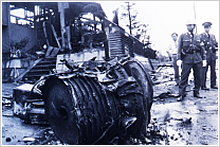
A U.S. military aircraft crashed in Eda-cho, Midori-ku (now Eda-Kita, Aoba-ku), killing young children. (1977)
The take-off and landing of aircraft carrier-based aircraft that began using the Atsugi base in 1973, along with the night continuous take-off and landing training (NLP) that began in 1982, made noise damage caused by U.S. military aircraft even more serious.
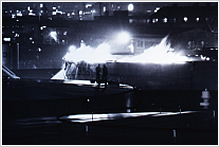
Tank No. 306 at Tsurumi Oil Storage Facility, which was burned down by a lightning strike. (1979)
The crash of the U.S. military jet aircraft in 1977 was a catastrophe that killed the precious lives of citizens. In addition, tank fires occurred one after another at two oil storage facilities that handle jet fuel from U.S. military aircraft, and the explosion and fire accident at the Koshiba oil storage facility caused widespread damage, including surrounding houses.
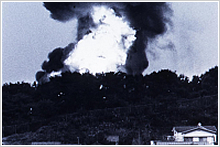
At the Koshiba oil storage facility, tank No. 6 (underground tank) exploded and burned. (1981)
With urbanization, incidents and accidents caused by the U.S. military and noise caused by U.S. military aircraft have become even more urgent issues, Yokohama City has been working with Kanagawa Prefecture and base-related cities in the prefecture, including the transfer of carrier-based aircraft. We are urging the government and the U.S. military to drastically solve noise problems and thoroughly implement safety measures.
| Showa | Major Events |
|---|---|
| 1948 | January 23: Japan-US agreement on the Kanto Air Force Facility Reorganization Plan, etc. September 27: Start using the Atsugi base of aircraft carrier-based aircraft |
| 50 years | April 30: The end of the Vietnam War |
| 1952 | September 27: U.S. military jet crash (Eda-cho, Midori-ku) December 15: Japan-US agreement to return the Yokohama Seaside Residential Area (No. 2), Negishi Residential Area (partial), Shinyamashita Residential Area and Yokohama Chapel Center |
| 1954 | July 27: Tsurumi Oil Storage Facility Fire Accident |
| 1956 | October 13: Koshiba Oil Storage Facility Explosion Accident |
| 1957 | February 16: First NLP implementation at Atsugi base March 31: Yokohama Seaside Residential Area, Shinyamashita Residential Area, Negishi Residential Area (partial) Return |
| 60 years | May 31: Establishment of Yokohama City Council Requisition Promotion Special Committee |
| 1962 | January 20: Launch of Aircraft Accident Liaison Council |
| 1963 | August 16: Established Atsugi Base Noise Countermeasures Council |
Inquiries to this page
Base Countermeasures Section, Urban Development Bureau Planning Department
Telephone: 045-671-2168
Telephone: 045-671-2168
Fax: 045-663-2318
Email address: tb-kichitaisaku@city.yokohama.lg.jp
Page ID: 220-124-154







